The mission, designated NG-11, marks the 11th time Cygnus will deliver cargo to the International Space Station for NASA and will complete the Commercial Resupply Services-1 (CRS-1) contract.
For the NG-11 mission, Northrop Grumman will showcase a number of new capabilities including late load operations and a solo, long duration post-ISS departure mission for Cygnus. In addition, the Antares medium-class rocket is set to carry its largest cargo load to date, transporting about 3,450 kilograms of vital supplies and scientific equipment aboard Cygnus.
Antares is carrying two secondary payloads on its second stage. These small satellites include one NASA-sponsored 3U CubeSat called Student Aerothermal Spectrometer Satellite of Illinois and Indiana CubeSat (SASSI2) and 60 ThinSats.
SASSI was built by students attending the Universities of Indiana and Illinois. The ThinSats program is a science, technology, engineering and mathematics outreach program sponsored by the Virginia Commercial Space Flight Authority for grades 4-12.
These satellites were built by students from 70 schools located in nine states (Arizona, Connecticut, Florida, Kentucky, Maryland, North Carolina, South Carolina, Virginia and West Virginia). After the ThinSats are deployed, students will collect and analyse data transmitted from their satellite for about five days before it deorbits and burns up in the atmosphere.
For the NG-11 mission, the company commemorates astronaut Lieutenant Commander Roger Chaffee, who was selected by NASA to fly on the first manned mission of the Apollo program in 1967. LCDR Chaffee, and crewmates, Virgil “Gus” Grissom and Ed White II, all died in a tragic accident after a fire occurred in the space capsule during a simulation of the Apollo 1 launch. Unlike his crewmates, LCDR Chaffee had not yet travelled to space.
The Cygnus spacecraft will represent LCDR Chaffee’s planned journey to space in memory of those who made the ultimate sacrifice so that others could pursue their dreams of space exploration.
On this mission the SS Roger Chaffee will demonstrate for the first time the ability to load cargo 24 hours before a scheduled launch. This capability allows time-sensitive payloads to be safely transported to the ISS.
Cygnus will be grappled by the crew aboard the ISS at approximately 5:30am EDT on 19 April 2019. The spacecraft will remain attached to the space station for about two months before departing with up to 3,500 kilograms of cargo for disposal. The removal of this disposable cargo is a crucial step in keeping the space station operational.
The advanced capabilities demonstrated on this mission allow the ISS to maximise its potential as an orbiting laboratory and fosters a new economy in low-Earth orbit. Including NG-11, Cygnus will have delivered about 30,000 kilograms of cargo under the CRS-1 contract. Future Cygnus missions will continue to showcase innovations benefiting the ISS, commercial partners and deep space missions.

